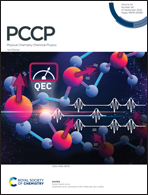Magnetic deep eutectic solvents: formation and properties†
Abstract
Deep eutectic solvents (DESs) are well-known as novel solvents due to their unique properties, which are indispensable for the development of green chemistry in the future. CoCl2·6H2O and NiCl2·6H2O-based DESs, which could be called magnetic DESs (MDESs) for short in view of their responsive behavior to an external magnetic field, have been widely used in many industrial applications, such as biomass treatment, electrolytes, and material preparation. For better application and full-scale development of these MDESs in various fields, eleven MDESs were prepared in this work by using CoCl2·6H2O and NiCl2·6H2O as hydrogen bond acceptors (HBAs) with alcohols, carboxylic acids and amides as hydrogen bond donors (HBDs), respectively. The intermolecular interactions between the components of MDESs were characterized via FTIR, 1H NMR and DSC analysis. In addition, physicochemical properties including density, viscosity, conductivity, ionicity, pH values, surface tension, thermostability and solvatochromic parameters were investigated. All MDESs exhibit acid characteristics and have good conductivity comparable with ionic liquids (ILs) and other DESs used for electrolytes. The results show that stronger H-bonding networks in Ni-based MDESs make them have higher density, viscosity, polarity and surface tension values than Co-based MDESs. Moreover, all prepared MDESs possess a good conductivity behavior which could be comparable to that of common organic solvents and ILs. According to this work, we could better comprehend the behavior of Co/Ni-based MDESs and choose the appropriate one for particular applications.

- This article is part of the themed collection: 2022 PCCP HOT Articles


 Please wait while we load your content...
Please wait while we load your content...